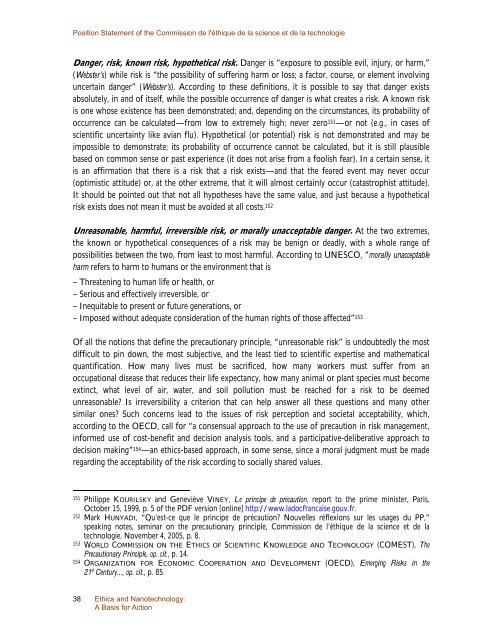A Basis for Action - Commission de l'éthique de la science et de la ...
A Basis for Action - Commission de l'éthique de la science et de la ...
A Basis for Action - Commission de l'éthique de la science et de la ...
Create successful ePaper yourself
Turn your PDF publications into a flip-book with our unique Google optimized e-Paper software.
Position Statement of the <strong>Commission</strong> <strong>de</strong> l'éthique <strong>de</strong> <strong>la</strong> <strong>science</strong> <strong>et</strong> <strong>de</strong> <strong>la</strong> technologie<br />
Danger, risk, known risk, hypoth<strong>et</strong>ical risk. Danger is “exposure to possible evil, injury, or harm,”<br />
(Webster’s) while risk is “the possibility of suffering harm or loss; a factor, course, or element involving<br />
uncertain danger” (Webster’s). According to these <strong>de</strong>finitions, it is possible to say that danger exists<br />
absolutely, in and of itself, while the possible occurrence of danger is what creates a risk. A known risk<br />
is one whose existence has been <strong>de</strong>monstrated; and, <strong>de</strong>pending on the circumstances, its probability of<br />
occurrence can be calcu<strong>la</strong>ted—from low to extremely high; never zero 151 —or not (e.g., in cases of<br />
scientific uncertainty like avian flu). Hypoth<strong>et</strong>ical (or potential) risk is not <strong>de</strong>monstrated and may be<br />
impossible to <strong>de</strong>monstrate; its probability of occurrence cannot be calcu<strong>la</strong>ted, but it is still p<strong>la</strong>usible<br />
based on common sense or past experience (it does not arise from a foolish fear). In a certain sense, it<br />
is an affirmation that there is a risk that a risk exists—and that the feared event may never occur<br />
(optimistic attitu<strong>de</strong>) or, at the other extreme, that it will almost certainly occur (catastrophist attitu<strong>de</strong>).<br />
It should be pointed out that not all hypotheses have the same value, and just because a hypoth<strong>et</strong>ical<br />
risk exists does not mean it must be avoi<strong>de</strong>d at all costs. 152<br />
Unreasonable, harmful, irreversible risk, or morally unacceptable danger. At the two extremes,<br />
the known or hypoth<strong>et</strong>ical consequences of a risk may be benign or <strong>de</strong>adly, with a whole range of<br />
possibilities b<strong>et</strong>ween the two, from least to most harmful. According to UNESCO, “morally unacceptable<br />
harm refers to harm to humans or the environment that is<br />
– Threatening to human life or health, or<br />
– Serious and effectively irreversible, or<br />
– Inequitable to present or future generations, or<br />
– Imposed without a<strong>de</strong>quate consi<strong>de</strong>ration of the human rights of those affected” 153<br />
Of all the notions that <strong>de</strong>fine the precautionary principle, “unreasonable risk” is undoubtedly the most<br />
difficult to pin down, the most subjective, and the least tied to scientific expertise and mathematical<br />
quantification. How many lives must be sacrificed, how many workers must suffer from an<br />
occupational disease that reduces their life expectancy, how many animal or p<strong>la</strong>nt species must become<br />
extinct, what level of air, water, and soil pollution must be reached <strong>for</strong> a risk to be <strong>de</strong>emed<br />
unreasonable? Is irreversibility a criterion that can help answer all these questions and many other<br />
simi<strong>la</strong>r ones? Such concerns lead to the issues of risk perception and soci<strong>et</strong>al acceptability, which,<br />
according to the OECD, call <strong>for</strong> “a consensual approach to the use of precaution in risk management,<br />
in<strong>for</strong>med use of cost-benefit and <strong>de</strong>cision analysis tools, and a participative-<strong>de</strong>liberative approach to<br />
<strong>de</strong>cision making” 154 —an <strong>et</strong>hics-based approach, in some sense, since a moral judgment must be ma<strong>de</strong><br />
regarding the acceptability of the risk according to socially shared values.<br />
151 Philippe KOURILSKY and Geneviève VINEY, Le principe <strong>de</strong> précaution, report to the prime minister, Paris,<br />
October 15, 1999, p. 5 of the PDF version [online] http://www.<strong>la</strong>docfrancaise.gouv.fr.<br />
152 Mark HUNYADI, “Qu’est-ce que le principe <strong>de</strong> précaution? Nouvelles réflexions sur les usages du PP,”<br />
speaking notes, seminar on the precautionary principle, <strong>Commission</strong> <strong>de</strong> l’éthique <strong>de</strong> <strong>la</strong> <strong>science</strong> <strong>et</strong> <strong>de</strong> <strong>la</strong><br />
technologie, November 4, 2005, p. 8.<br />
153 WORLD COMMISSION ON THE ETHICS OF SCIENTIFIC KNOWLEDGE AND TECHNOLOGY (COMEST), The<br />
Precautionary Principle, op. cit., p. 14.<br />
154 ORGANIZATION FOR ECONOMIC COOPERATION AND DEVELOPMENT (OECD), Emerging Risks in the<br />
21 st Century..., op. cit., p. 85.<br />
38 Ethics and Nanotechnology:<br />
A <strong>Basis</strong> <strong>for</strong> <strong>Action</strong>
















